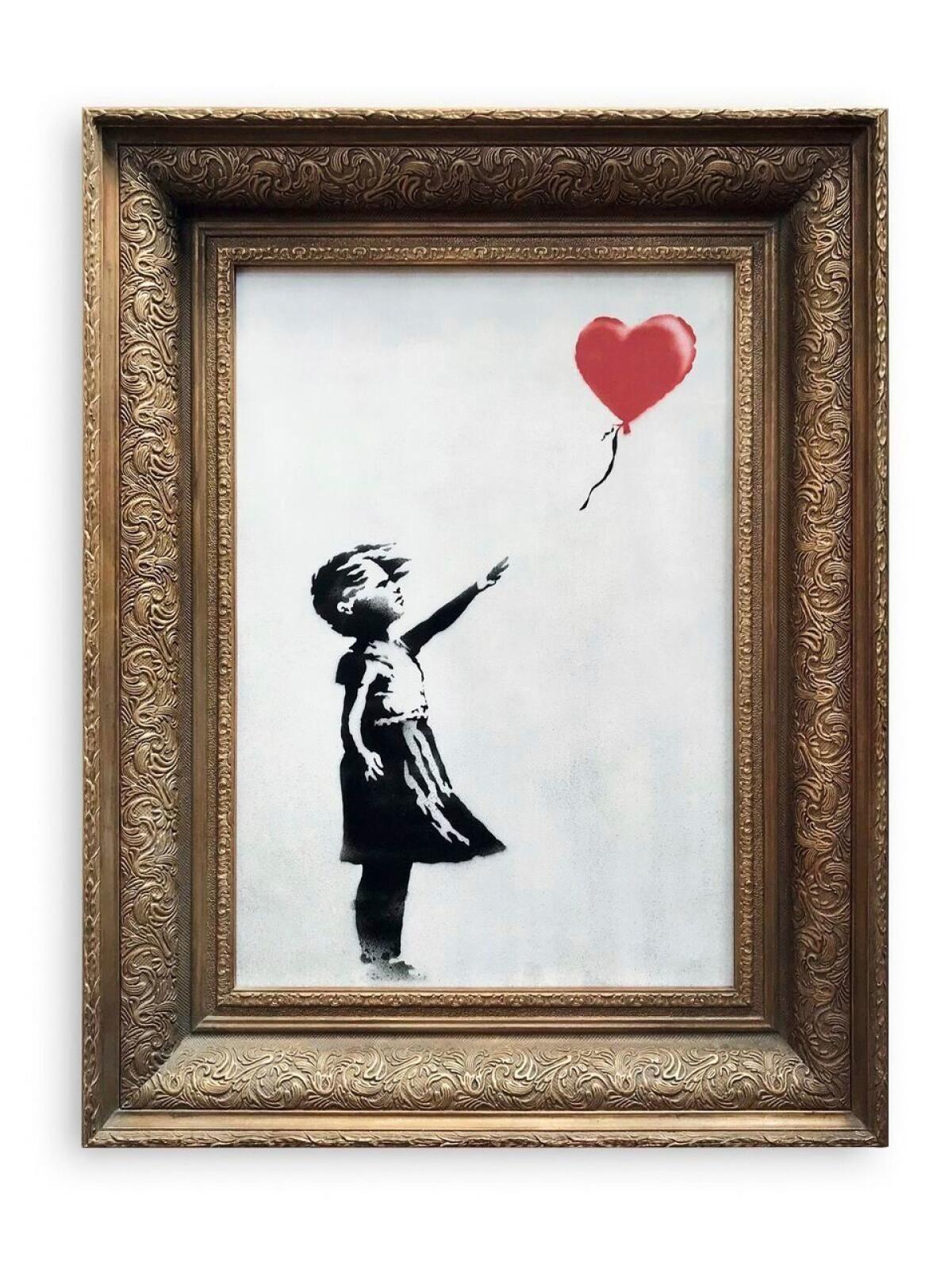Critic’s Notebook: Is Banksy bursting an inflated auction balloon?

- Share via
Art auctions walk a tightrope between fairness and fraudulence.
An auctioneer calling out steadily ascending prices until just one buyer remains is an efficient way to value an asset based on market demand.
Yet, there are many ways to tinker with the process. Keeping the identities of buyers and sellers secret, using shill bidders to inflate prices, posting a “chandelier bid” as an auctioneer fabricates an offer from thin air to inflate the appearance of demand — in most such instances, the auction house holds all the cards.
Over the weekend, news flashed around the world that a painting by celebrity London street artist Bansky had self-destructed on an auction house wall — just moments after fetching a record price. My first response, I suspect like most people’s, was to guffaw at the startling absurdity of the sight.
My second was to imagine the tightrope turning into a noose.
Seriously? We are supposed to believe this ridiculous story?
We are supposed to believe that a painting that committed suicide through a weighty shredding mechanism hidden behind the backing just happened to be the very last item in a routine modern art auction studded with famous names?
A painting whose seller and buyer are both a secret? A small work (about 40 by 31 inches) atypically hung on a side wall next to a row of stunned (but photogenic) auction-house employees, rather than up front and alone on an easel or turntable?
Banksy’s unremarkable “Girl with Balloon” was painted in 2006 and has been held by the same anonymous collector ever since. So, we’re supposed to accept that the showman set up his prank and then lay in wait — for 12 years — until he pulled the trigger at the exact right moment and stopped the global presses.
The usual Banksy fan-boys jumped in to laud the artist for an allegedly devastating critique of the roaring market, which has come to dominate art’s social value, by demolishing his own $1.4 million painting right before the world’s very eyes. Banksy popped the innocent child’s inflated balloon! What a genius!
Near as I can tell, though, this ostensible market critique has mostly revolved around whether the media spectacle has raised or lowered the shredded work’s monetary value. (“Raised” seems to be the immediate and unremarkable consensus.) So much for insightful critique.
Now that the initial flood of gee-whiz stories is done, the second wave of skeptic stories (like this one) appear. Sotheby’s, the London auction house where the self-annihilation took place, gets a one-two punch of jazzy free publicity.
Auctions need it. It’s worth noting that the Banksy shredder story was catapulted less by an artist’s ostensibly shrewd audacity than by our general market distrust — which includes distrust of auction houses like Sotheby’s. Auctions’ past role as a rousing measure of market demand has largely been replaced by their current sterile function as the site for the dull transfer of asset classes between cash and art.
This is how auction-watcher Lee Rosenbaum put it on her CultureGrrl blog in the spring: “Bargains are struck in advance with third-party guarantors who ensure (for a fee and/or a share of the proceeds) that high-priced works will sell, either to them or to someone who steps in at a level where the guarantor can step aside. These are not public auctions, as traditionally understood; they’re private arrangements, in which the public consummation is often a foregone conclusion.”
As prices have inflated to gigantic proportions, the competition for product among rival houses has led to ever more complex and arcane arrangements with sellers and buyers. The art market is mostly unregulated, and opacity in the auction market is more extreme than ever. Banksy’s prank could not have happened without it, nor been catapulted without it either.
The auction-thrill is gone, Rosenbaum concluded in May. Last Friday night, a million-dollar painting got shredded. Whoop-de-doo.
Twitter: @KnightLAT
More to Read
The biggest entertainment stories
Get our big stories about Hollywood, film, television, music, arts, culture and more right in your inbox as soon as they publish.
You may occasionally receive promotional content from the Los Angeles Times.











